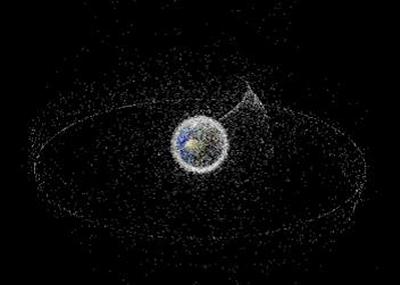Research challenge
Research on space debris has been conducted at the University of Southampton since 1990. This has been supported by the Defence Evaluation and Research Agency (DERA), QinetiQ, UK Space Agency and the Engineering and Physical Sciences Research Council (EPSRC).
In 1999, Dr Graham Swinerd argued that more research should be carried out into debris in High Earth Orbit (HEO) and especially in Geostationary Earth Orbit (GEO) where many active satellites are located. These account for most of the revenue from commercial space services including broadband internet and direct to home entertainment. This led to the development (with Dr Hugh Lewis) of the Debris Analysis and Monitoring Architecture for the Geosynchronous Environment (DAMAGE), a simulation model of the GEO debris environment including a fast propagator, enabling studies of millions of orbits.
Context
Most people in the world reap the benefits of space systems. Revenues from commercial space products and services reached £70 billion in 2011 (40 per cent of the global space economy). The biggest demand comes from Global Positioning System (GPS) devices and direct-to-home (DTH) television, but space technology also plays a vital role in responding to natural disasters that affect hundreds of millions of people each year. Without space infrastructure, the ability to manage humanitarian aid and water resources, to deliver health care, telephone and internet services in remote areas, among other vital services, would disappear and millions of people would be adversely affected.
Within this context, the UN described space debris as one of the top-ten issues of 2008 having important implications for mankind, alongside climate change and the global food crisis.
Our solution
Dr Lewis, who serves on the IADC, the inter-governmental agency coordinating worldwide activities related to space debris, used Southampton’s DAMAGE simulation tool to help design updates to the IADC Space Debris Mitigation (SDM) Guidelines. Collaborative research using DAMAGE was conducted by Southampton with QinetiQ and the US Aerospace Corporation to assess the importance of the initial shape, or eccentricity, of the ‘graveyard’ orbits where retired spacecraft are placed.
The IADC reported to the UN in 2000 that the shape of these graveyard orbits did not need to be circular because altitude variations arising from elliptical orbits would reduce the collision probability within the graveyard. However, Dr Lewis was able to use his research findings and capabilities of the DAMAGE simulation tool to influence the guidelines for disposing of GEO spacecraft. He recommended the graveyard orbit should be nearly circular with a maximum eccentricity of 0.005. This shape ensures that retired spacecraft do not return to the geostationary ring and pose a risk to active spacecraft there.
In event, the IADC SDM guidelines were updated reflecting a more conservative maximum orbit eccentricity requirement of 0.003.
Our impact
The new IADC SDM guideline ensures that valuable ‘real estate’ in the geostationary orbit is freed for future use, interference with active satellites is minimised, and collisions resulting in the debris in the GEO environment are prevented.
Advice by Dr Lewis, backed by robust evidence from his model, has been critical for the future growth of the UK and international space sector, which relies on revenues from communications satellites in geostationary orbit. He has also informed the public debate over the threats from space debris, through evidence given to the House of Commons Science and Technology Committee and through an interview on a BBC World News Today programme in 2011.
